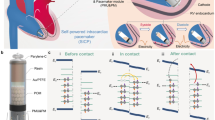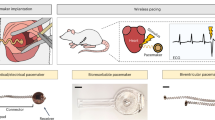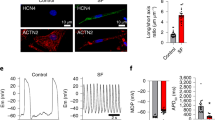Abstract
The pacemaker cells of the heart initiate the heartbeat, sustain the circulation, and dictate the rate and rhythm of cardiac contraction1. Circulatory collapse ensues when these specialized cells are damaged by disease, a situation that currently necessitates the implantation of an electronic pacemaker2. Here we report the use of viral gene transfer to convert quiescent heart-muscle cells into pacemaker cells, and the successful generation of spontaneous, rhythmic electrical activity in the ventricle in vivo. Our results indicate that genetically engineered pacemakers could be developed as a possible alternative to implantable electronic devices.
This is a preview of subscription content, access via your institution
Access options
Subscribe to this journal
Receive 51 print issues and online access
$199.00 per year
only $3.90 per issue
Buy this article
- Purchase on SpringerLink
- Instant access to full article PDF
Prices may be subject to local taxes which are calculated during checkout

Similar content being viewed by others
References
Brooks, C. M. & Lu, H.-H The Sinoatrial Pacemaker of the Heart (Thomas, Springfield, Illinois, 1972).
Kusumoto, F. M. & Goldschlager, N. N. Engl. J. Med. 334, 89–97 (1996).
Wobus, A. M., Rohwedel, J., Maltsev, V. & Hescheler, J. Ann. NY Acad. Sci. 752, 460–469 (1995).
Kubo, Y., Baldwin, T. J., Jan, Y. N. & Jan, L. Y. Nature 362, 127–333 (1993).
Herskowitz, I. Nature 329, 219–222 (1987).
Slesinger, P. A. et al. Neuron 16, 321–331 (1996).
Irisawa, H., Brown, H. F. & Giles, W. Physiol. Rev. 73, 197–227 (1993).
Santoro, B. & Tibbs, G. R. Ann. NY Acad. Sci. 868, 741–764 (1999).
Imoto, Y., Ehara, T. & Matsuura, H. Am. J. Physiol. 252, 325–333 (1987).
Hirano, Y. & Hiraoka, M. J. Physiol. (Lond.) 395, 455–472 (1988).
Rodriguez-Contreras, A., Nonner, W. & Yamoah, E. N. J. Physiol. (Lond.) 538, 729–745 (2002).
Campbell, D. L., Giles, W. R. & Shibata, E. F. J. Physiol. (Lond.) 403, 239–266 (1988).
Brown, H. F., Kimura, J., Noble, D., Noble, S. J. & Taupignon, A. Proc. R. Soc. Lond. B 222, 329–347 (1984).
Author information
Authors and Affiliations
Ethics declarations
Competing interests
The authors declare no competing financial interests.
Rights and permissions
About this article
Cite this article
Miake, J., Marbán, E. & Nuss, H. Biological pacemaker created by gene transfer. Nature 419, 132–133 (2002). https://doi.org/10.1038/419132b
Issue date:
DOI: https://doi.org/10.1038/419132b
This article is cited by
-
Analysis of Circulating Waves in Tissue Rings derived from Human Induced Pluripotent Stem Cells
Scientific Reports (2020)
-
A study of the outward background current conductance gK1, the pacemaker current conductance gf, and the gap junction conductance gj as determinants of biological pacing in single cells and in a two-cell syncytium using the dynamic clamp
Pflügers Archiv - European Journal of Physiology (2020)
-
Ionic and cellular mechanisms underlying TBX5/PITX2 insufficiency-induced atrial fibrillation: Insights from mathematical models of human atrial cells
Scientific Reports (2018)
-
Next-generation pacemakers: from small devices to biological pacemakers
Nature Reviews Cardiology (2018)
-
A Singular Role of IK1 Promoting the Development of Cardiac Automaticity during Cardiomyocyte Differentiation by IK1 –Induced Activation of Pacemaker Current
Stem Cell Reviews and Reports (2017)



